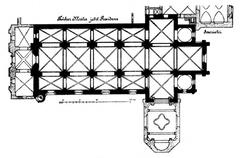
St. Anthony Basilica, Rybnik: Visiting Hours, Tickets, History, and Travel Guide
Date: 04/07/2025
Introduction
Located in the heart of Rybnik, Poland, the Basilica of St. Anthony of Padua is a breathtaking example of Neo-Gothic architecture and a cornerstone of Silesian religious and cultural heritage. Towering above Rybnik with its twin spires, the basilica has evolved from a humble chapel into the region’s tallest church and a major pilgrimage site. Whether you are a history enthusiast, architecture lover, or spiritual seeker, a visit to St. Anthony Basilica offers a profound encounter with Poland’s ecclesiastical artistry and community life (Travelodium; exploreyourlife.eu; GCatholic).
Table of Contents
- Historical Overview
- Architectural and Artistic Highlights
- Religious Significance and Community Life
- Visitor Information: Hours, Tickets & Accessibility
- Guided Tours, Special Events, and Etiquette
- Nearby Attractions and Suggested Itinerary
- Practical Tips for Visitors
- Frequently Asked Questions (FAQ)
- Conclusion and Further Resources
Historical Overview
Early Roots and Growth
Catholic worship in Rybnik dates back to the early 19th century, with parishioners initially gathering in a modest castle chapel. As Rybnik’s Catholic community flourished, the need for a larger, dedicated church became pressing. Construction of the present basilica began in 1896 under Father Edward Cybichowski, culminating in its consecration in 1902 (Travelodium; Codelt).
From Parish Church to Minor Basilica
Overcoming wartime damage and benefiting from post-war restoration, the church gained recognition as a major spiritual hub. In 1992, Pope John Paul II elevated it to minor basilica status, cementing its importance within the Catholic Church and Silesian culture (GCatholic).
Architectural and Artistic Highlights
Neo-Gothic Splendor
Designed by Ludwig Schneider, St. Anthony Basilica is a masterpiece of Neo-Gothic architecture. Its defining features include:
- Twin Spires: Reaching 96 meters, the tallest in Upper Silesia (exploreyourlife.eu).
- Red Brick Façade: Adorned with ornate carvings, pointed arches, and a grand rose window.
- Buttresses and Pinnacles: Enhancing the verticality and Gothic character.
Interior Artistry
Stepping inside reveals:
- Vaulted Nave: Supported by slender columns and ribbed vaults, drawing the gaze upward.
- Stained Glass Windows: Vivid biblical scenes and saints are depicted in early 20th-century glasswork. The rose window above the entrance is a particular highlight.
- Altars and Statues: The high altar, side chapels, and numerous sculptures exemplify expert craftsmanship and devotion.
- Historic Pipe Organ: Installed in 1965, restored after a 2009 lightning strike, it remains integral to the basilica’s musical tradition.
Integration with Urban Space
Situated by John Paul II Square, the basilica is both a spiritual beacon and a focal point for Rybnik’s gatherings and processions (exploreyourlife.eu).
Religious Significance and Community Life
Patronage of St. Anthony of Padua
Dedicated to St. Anthony, the patron saint of lost things and protector of the needy, the basilica attracts pilgrims seeking intercession and solace (Travelodium).
Liturgical and Community Activities
Regular Masses, sacraments, and feast days, especially the June 13th celebration of St. Anthony’s feast, foster community spirit. The basilica is also a destination during Catholic Jubilee Years and is recognized for its role in regional religious life (Polska Kultura; GCatholic).
Visitor Information: Hours, Tickets & Accessibility
- Opening Hours: Generally 8:00 AM–6:00 PM (Mon–Sat), 1:00 PM–6:00 PM (Sun). Check the official website for updates.
- Admission: Free for all visitors. Donations for maintenance are appreciated.
- Accessibility: Main entrance ramp and accessible restrooms; assistance available upon request.
- Language: Polish predominates, but English is understood by some staff and guides (Key to Poland).
Getting There
- Location: Ul. Mikołowska 4, Rybnik.
- By Train: Rybnik station is a 15-minute walk.
- By Car: Parking is available nearby, though limited during major events.
- From Airports: Katowice Airport is about 40 km away, with transfers by taxi or regional train (davidstravelguides.com).
Guided Tours, Special Events, and Etiquette
- Guided Tours: Book via the parish office; some tours may require a small fee.
- Special Events: Major feasts, concerts, and processions—especially during Christmas, Easter, and St. Anthony’s Day—provide unique cultural experiences.
- Dress Code: Modest attire (shoulders/knees covered), hats removed, and a respectful demeanor are required.
- Photography: Permitted outside of services; avoid flash and tripods.
Nearby Attractions and Suggested Itinerary
- Rybnik Market Square (Rynek): Vibrant cafés, local shops, and cultural events (Market Square).
- Rybnik Castle: Explore medieval history (Rybnik Castle).
- Church of Our Lady of Sorrows: Nearby architectural gem.
- Edukatorium Juliusz: Interactive museum on medical history (Housity.net).
- Rybnik Reservoir: Ideal for outdoor activities (Rybnik Reservoir).
Suggested Day Plan:
Morning at the basilica; midday stroll around the market square and castle; afternoon in the city’s parks or at the reservoir.
Practical Tips for Visitors
- Currency: Polish złoty (PLN); ATMs and cards widely accepted (Feather and the Wind).
- Transport: Reliable trains/buses; walking is easiest in the center.
- Weather: Summers are mild; winters can be snowy.
- Safety: Very safe; emergency number is 112.
- Food: Try Silesian specialties at local restaurants.
Frequently Asked Questions (FAQ)
Q: What are the opening hours?
A: Typically 8:00 AM–6:00 PM (Mon–Sat), 1:00 PM–6:00 PM (Sun); verify during holidays.
Q: Is entry free?
A: Yes; donations are welcome.
Q: Are guided tours available?
A: Yes, arrange through the parish office.
Q: Is the basilica accessible for visitors with disabilities?
A: Yes; main ramp and accessible restrooms.
Q: Can I take photographs inside?
A: Yes, except during Mass; avoid flash.
Q: Where can I park?
A: Parking near John Paul II Square; limited during events.
Conclusion and Further Resources
St. Anthony Basilica in Rybnik stands as a beacon of faith, art, and community. Its soaring spires, luminous stained glass, and vibrant liturgical life tell the story of a resilient city and a living tradition. Whether you visit for spiritual reflection, architectural discovery, or cultural exploration, the basilica and its surroundings promise a rewarding experience.
For more travel insights and audio-guided tours, download the Audiala app and consult the following resources:
For the latest updates, visit the official basilica website and the Rybnik Tourism Office.


